Life in Harmony with Nature – Cooperation Not Competition With All That Surrounds Us:
Hawaiian Culture as Represented in SURFING FOR LIFE
“A sense of being one with all of creation, being one with the ocean, being one with the heavens…there’s a feeling of completeness.” Anona Napoleon – SURFING FOR LIFE
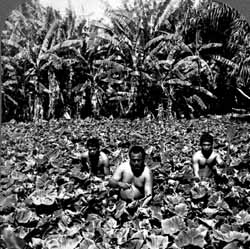
The ‘aina (land) is not just soil, sand or dirt. The ‘aina is a heart issue for Hawaiians. The very word ‘aina brings forth deep emotion evolved from ancestral times when people lived in nature as an integral part of it. Mankind and nature were considered siblings born to the same parents at the beginning of time.
The word ‘aina literally means “that which feeds,” and maka ‘ainana, a term for the common class of people, means “eyes of the land.” Thus, nature feeds man and man watches over nature in return. The land gave the ancients everything they needed–not just food, but clothing, housing, weapons, tools, musical instruments, canoes–everything they crafted, wore and ate came from plants, animals or fish. Dependent on nature, they revered and respected it. Success depended on living in harmony with nature.
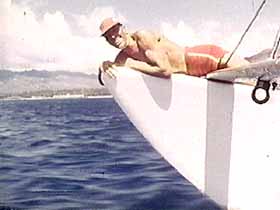
For Hawaiians, the stars in the sky are the Mother, the sky is the Father, the Earth is the Grandmother, the Kalo (Taro) plant is the elder brother, and the Islands are the Aunties and Uncles. Hawaiians can trace their genealogy back to all things… the earth, sky, stars, and the Kalo. Thus, the connection between ‘ohana (family) and the ‘aina (land) is very strong.
A Genealogical Connection
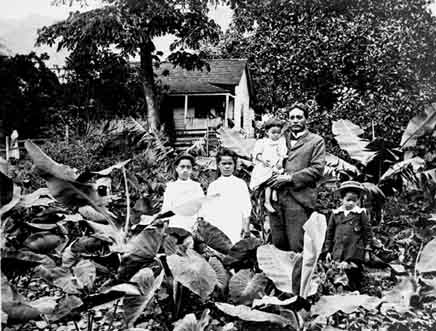
“Na ali’i o ke kuamo’o o Haloa”
Chiefs of the lineage of Haloa…
Said of high chiefs whose lineage goes back to ancient times.
Mary Kawena Puku’i – ‘Olelo No’eau
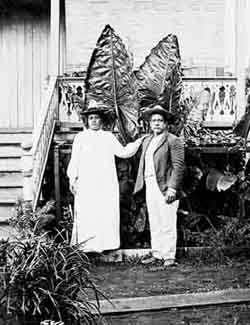
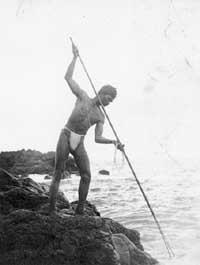
From this emotional and spiritual connection to nature, to all that’s around them, Hawaiians invented the term Malama– “to take care of..” To Malama the ‘aina or kai (sea), to take care of the land and the sea, to protect and conserve the environment, is directly linked to protecting and conserving the ‘ohana and all people of good will.
Aloha
When Woody Brown arrived in Hawai’i in 1940 (as told in SURFING FOR LIFE), he was recovering from the devastating death of his wife during childbirth. As he traveled throughout the islands, he experienced overwhelming warmth, generosity and hospitality from the native Hawaiian people he met. This is the famous aloha spirit that the world has come to identify with Hawai’i, and it was Woody’s salvation.
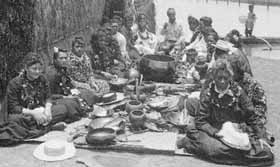 Herb Kane, artist, writer and co-founder of the Polynesian Voyaging Society, defines aloha the following way: “An unquestioning friendship and desire to share, developed within the ‘ohana but extended to all persons of good will, aloha has been variously defined as affection, compassion, mercy, sympathy, civility, kindness and charity. It is given without restraint or ulterior motive, and it is expressed with a geniality which springs from one who is secure in his society and his environment.” The “aloha spirit” is a friendliness, a caring, a willingness to be helpful, most often expressed as the hospitality (Ho’okipa) that Woody experienced over 60 years ago.
Herb Kane, artist, writer and co-founder of the Polynesian Voyaging Society, defines aloha the following way: “An unquestioning friendship and desire to share, developed within the ‘ohana but extended to all persons of good will, aloha has been variously defined as affection, compassion, mercy, sympathy, civility, kindness and charity. It is given without restraint or ulterior motive, and it is expressed with a geniality which springs from one who is secure in his society and his environment.” The “aloha spirit” is a friendliness, a caring, a willingness to be helpful, most often expressed as the hospitality (Ho’okipa) that Woody experienced over 60 years ago.
Love of the Land and the Ocean
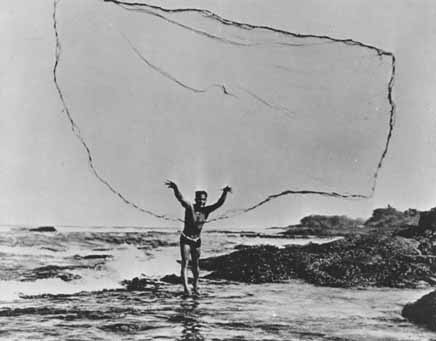
John Kelly- SURFING FOR LIFE
Love and caring for the land is aloha ‘aina and the same attitude toward the sea is aloha kai. These ideas illustrate the love and respect that Hawaiians have for the world around them, the same love, affection and respect they feel for their ‘ohana and all people of good will.
There were kapu (taboos) set on what one could take from the land and from the sea; conservation was practiced in fishing as well as hunting and gathering of wild plants. Hawaiians took only what they needed from their environment and that respect enabled them to have some of the most productive agriculture and aquaculture throughout the Pacific.

The Meaning of Family for Hawaiians
“Family is the glue that holds life together”
Shay Bintliff- SURFING FOR LIFE
Ancient Hawaiian children grew up in a warm and affectionate world where people not related by blood were considered part of the ‘ohana, or extended family. To Hawaiians, the family consisted not only of the usual blood relatives, but also those who were loved or who chose to participate in cooperative actions.
The ‘ohana is not unique to Hawai’i or to Polynesia. The extended family or clan structure is universal in human society, although it’s more pronounced in agrarian societies before the emergence of individualism and market economies. Hawaiians and Polynesians were very much aware of themselves as a member of the larger ‘ohana.

Respect for Our Elders
“The Polynesian universe was ordered on the concept of unquestioning deference towards elders.” Herb Kane – VOYAGERS
In Hawaiian tradition, there is a great respect for elders (kupuna) which surpassed any feelings of individuality. In old Hawai’i, kupuna were respected as keepers of Hawai’i’s wisdom and knowledge. Still today, younger Hawaiians are told: Nana i ke kumu, “look to the source.”
Seniority has for countless generations been a key factor in a person’s status in Hawaiian society. Other residents of the youth-oriented United States can learn much from the Hawaiians about respecting and revering the wisdom of the elderly. This is also a central theme of SURFING FOR LIFE. The older surfers in the film are inspirational models of healthy, successful aging and of passionate involvement – both in life and in the ancient Hawaiian sport they love. They also embody the Hawaiian values of ‘ohana and aloha. Hawaiians, in general, to their eternal credit, are still known as a people of a loving and generous nature. Hawaiian culture has left an important, humanizing legacy for the world, and SURFING FOR LIFE honors that contribution.
Hawaiian Music – A Brief History

The general history of Hawaiian music begins in the mid 1800s, when visitors from all over the planet came by sea to Hawai’i, bringing with them instruments such as the violin, guitar, ukulele, piano, accordion and flute. Hawaiian music was rooted in old religious chants and hymns, which the native Hawaiians then mixed with the musical rhythms, sounds and instruments they heard from international visitors, immigrants and missionaries. Secular music was influenced by a variety of people including those of Mexican, Italian, German and Burmese descent.
When early Mexican cowboys (paniolo), then still under Spanish rule, came to Hawai’i in the mid-1800s, they brought their guitars with them and taught the Hawaiians to play them in the Spanish style. The Hawaiians had innate musical talent and many became quite interested in the guitar. They largely followed the paniolo lead in guitar style and tuning. But, the Hawaiians soon adapted the tuning of the guitar to suit their own traditional Hawaiian songs and chants, loosening the guitar strings or “slacking” them. This allowed them to play bass on the loosened bass strings while playing a song’s melody on the treble strings. They played a finger picking style with a steady rhythm to accompany singing and hula dancing.
The slack key guitar method became so popular that families began developing their own unique styles and were very protective of their string tuning secrets. For this reason the slack key guitar style wasn’t openly shared or taught within the islands for a considerable time. Ki ho’ alu, or slack key has been called Hawai’i’s back porch music, folk music and soul music. Its beautiful rhythms and magical way of capturing the aloha spirit are now taking international center stage. Slack key guitar — melodious, intimate and relaxing — is a sound now being sought the world over. Slack key festivals are popping up all over the Mainland and in many countries including Japan.
Hawaiian music is also distinguished by its steel guitar style which was invented and developed in Hawai’i, largely by accident. In adapting the guitar to suit their own musical styles, Hawaiians often used a steel object and later a crafted steel bar to slide along the strings, producing a unique tone which was then integrated into the developing Hawaiian sound. The exact origins of the style and its technical inventor are widely debated; but three individuals — Hoa, Davion and Kekuku — may have discovered the technique independently of one another and are credited as its inventors. The steel guitar was featured in several Hawaiian bands in the early 1900s, as well as on some of the earliest recordings of Hawaiian music.
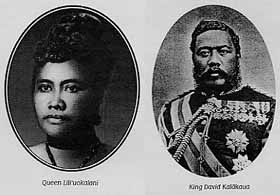
Among the numerous musical influences on Hawaiian music as it evolved were gospel music, American pop such as Stephen Foster, country and western, ragtime, swing, European light opera, and jazz. The Hawaiian eclectic genius was to blend all of these international influences with their own sophisticated rhythms and guitar stylings, and to make the mix uniquely their own. After its introduction in the United States and Canada, Hawaiian music found its way to Europe during the early 1900s. The music combined slack-key and steel guitar with prominent use of the ukulele mixed with traditional Hawaiian chants and tones, The Mainland home of Hawaiian music in the ’20 and ’30s was the Lexington Hotel Lounge in New York, ruled by Hawaiian band leader Ray Kenney.
There were many Hawaiian musical troupes touring the U.S. and Europe in the first three decades of the 20th century. One of the most popular, Jenny Wilson and her troupe of hula dancers, performed in Germany and throughout Europe. Prominent among the ambassadors of Hawaiian music in the 1920s and ’30s was The Tau Moe Family which had considerable influence on the evolution of early Hawaiian music. Tau Moe, his wife and two children traveled the world in the 1920s and beyond, showcasing Hawaiian music and culture as “The Aloha Four”. The group was one of the first to tour Europe during the Hawaiian cultural expansion, and for many years the family of four played in Europe, India and Asia.
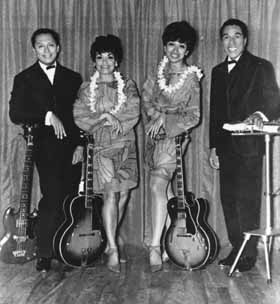
In Hawai’i, Tau Moe learned the steel guitar from M.K. Moke. He soon met another steel guitar player, Rose, who was to become his wife. The two joined a travelling show and began showcasing their musical talents. They couple had their first child, Lani, in Japan, and she too joined the family act that would come to be known, with the birth of son, Dorian, as the “Aloha Four.”
During the 1920s, Hawaiian music was sweeping the world with its own lilting and melodic sound. At the height of their popularity, Tau Moe and his family played for numerous world leaders in Germany, in Paris, Brussels and Japan, mesmerizing foreign audiences. They worked with a circus troupe, toured with the Josephine Baker show to Venice and played steel guitar music to an eager audience in Egypt. They also were profiled frequently in the press.
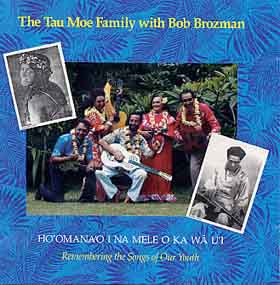
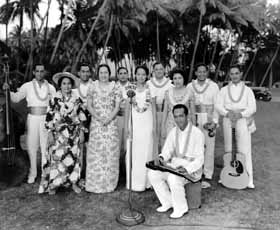
The American craze over Hawaiian music began to fade in the late 1950s and ’60s as other new music styles (especially rock and roll) took hold on the Mainland. But by the early ’70s, Hawaiian music began to return to the mainstream and gained significant recognition and respect through the work of some of Hawaii’s finest musicians, who spawned a revival of traditional Hawaiian music and also introduced newer styles. These great musicians, such as Gabby Pahinui, Eddie Kamae and The Sons of Hawai’i, have imprinted Hawaiian music on the world scene as much more than a trend. The music — beautiful, distinctive and long-lasting — represents the tonal and rhythmic expression of aloha.

To many, Gabby Pahinui is synonymous with the resurgence of Hawaiian music. Interestingly, the great Hawaiian musician didn’t like Hawaiian music as a boy. Growing up, Gabby was a fan of classic American jazz which greatly influenced his music over the years. As a boy, Gabby was a child musical genius. He was self-taught and never learned to read music. He learned to play the stand-up bass at age ten and started playing gigs as a child. Much to his parents dismay, he preferred to listen to his favorite jazz artists — Benny Goodman, Duke Ellington, Lionel Hampton and others. Gabby learned to play many of the jazz harmonies of the time and especially liked “modern jazz.”
Although the influences of jazz are evident in Gabby’s music, he was Hawaiian to the core. Gabby gained fame through his melding of jazz with traditional Hawaiian music and the slack key guitar. He first began playing slack key guitar in the early ’40s and recorded Hi’ilawe, his first hit, in 1947. He learned his slack key from a Hawaiian musician named Herman, and has referred to him as the greatest slack key musician he had ever seen. Gabby picked up slack key guitar and made it his own, incorporating his favorite jazz rhythms and beats. Over the course of his lifetime, he was a major force in bringing slack key, previously a non-taught technique kept within the ‘ohana or extended family, out into the open and to a very wide audience.
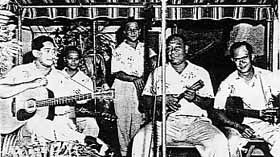
His talent was so impressive that it obscured his sometimes ostentatious behavior. As a young man, Gabby often infuriated club owners by his behavior during the gigs he played. He was continuously irresponsible, he had a drinking problem for years, and was a poor money manager. But he enjoyed a joyful and vivacious life that led him to be adored by almost everyone who met him. Club owners, no matter how annoyed they were by his behavior, could not dispute that Gabby had an incredible natural talent, even as a very young performer.
Gabby’s club circuit spanned almost 40 years during which he played with almost every important local musician — Eddie Spencer, Andy Cummings, Tommy Carter, Joe Kaimi, George Kainapau, Gigi Royce, Alvin Isaacs, Eddie Kamae, David Nale, Fred Punahoa, and Abraham Maenwa. During the 1940s and ’50s, Gabby spent a long time playing with Andy Cummings and his Hawaiian Serenaders. In the mid-sixties he began to concentrate on recording albums and concerts. In 1959, he joined Eddie Kamae in founding the highly influential group, The Sons of Hawai’i and continued to pursue solo slack-key guitar recordings. The Sons then recorded two great albums in the ’60s.
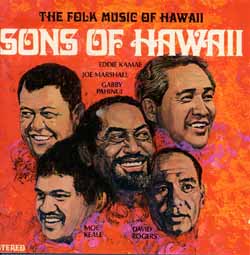
After his last album with The Sons of Hawai’i, Gabby made an album of his own with his four sons called “Rabbit Island Music Festival.” A few years later, he recorded “The Gabby Pahinui New Hawaiian Band” with mainland guitarist Ry Cooder who has said that Gabby was perhaps the finest guitar player he had ever met in his life. Gabby joined Cooder in recording another album, “Chicken Skin,” notable for its worldwide release by Warner Brothers. In 1977, Gabby released another album, “Gabby Pahinui’s Hawaiian Band, Vol 2” that was widely hailed as a milestone in Hawaiian music.
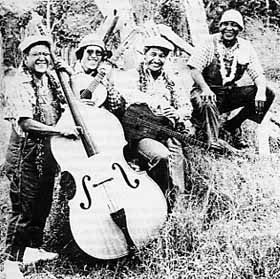
The Sons of Hawai’i, who recorded their first albun in 1962, represents a cross-section of Hawaii’s greatest musicians. The group was formed by Gabby and Eddie Kamae, the islands finest ukelele player, and originally included David “Feet” Rogers on steel guitar, and Joe Marshall on bass. Each of these musicians brought with him a lifelong love of music and considerable musical expertise and experience. The group spent four months together collaborating, sharing their ideas, rehearsing and trying to develop a sound that would express a group identity. In 1960, the group’s sound began to gain widespread popularity when they opened at The Sandbox in Honolulu and after the release of their first album in 1962. (Hula Records 503).
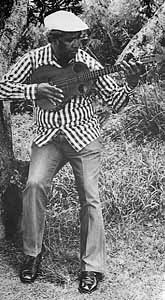
Between 1973 and 1982, The Sons underwent three more incarnations. In 1973, Dennis Kamakahi, a recognized Hawaiian singer and songwriter, joined in. Gabby did not take part. In 1977, Keale left the group, and in 1982 guitarists George Kuo and Raymond Balles joined forces. Rogers had fallen sick with Cancer.
Since 1992, Kamae had divided his time between music and a career making documentary films focused on Hawaiian music and culture. But the group he founded and leads, The Sons of Hawai’i continues to perform their wonderful music and to ensure their lasting mark on Hawaiian music and the world. For over 40 years, The Sons have popularized the slack-key and steel guitar sounds and have creating many classic Hawaiian songs, an eloquent and beautiful tribute to the Hawaiian culture and language.
Hawaiian musicians, notably Gabby Pahinui, Tao Moe, the Sons of Hawai’i, helped transform Hawaiian music and its unique styles from a music closely guarded by families (the ‘ohana) to one which was openly shared by Hawaiians with the world. Styles that had been passed on from father to son were embraced on the Mainland when audiences were thrilled by Hawai’i’s most talented musicians. Hawaiian musicians have also adapted other musical styles to fit into what is uniquely Hawaiian, continuing the eternal evolution of the music. The popularity of slack key and steel guitar has continued in recent years as an integral part of an island movement to explore and restore traditional Hawaiian culture to its people.
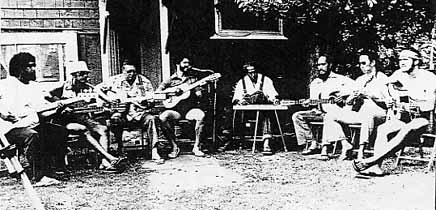
Other Hawaiian Musicians, Record Companies
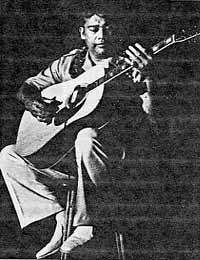
Four record companies licensed this beautiful Hawaiian music for our use in SURFING FOR LIFE. Three of the labels have specialized in Hawaiian music, and we want to honor their work in recording and distributing so much fine music from the Islands of Aloha. Here are brief histories of Hula Records (now Hawai’i Calls), Panini Records and Dancing Cat Records.
PANINI RECORDS, INC.
Panini Records has been recording Hawaii’s finest music for over 30 years. It was founded by Lawrence Brown, Witt Shingle, and Steve Siegfried in 1971. The Label’s first release was the milestone record, The Sons of Hawai’i, which achieved enormous recognition and a large new audience for Hawaiian Music.
Panini Records also recorded slack key guitar great Gabby Pahinui. The Label’s second album, released in 1972, was made with Gabby Pahinui and entitled Gabby. The album featured Gabby, and his sons Bla, Phil, Cyril and Martin Pahinui in a focus on slack-key guitar and strong vocals. A year later, Gabby recorded Rabbit Island Music Festival with Panini, this time he and his sons were joined by Sonny Chillingworth, Leland Isaacs, and Randy Lorenzo. Panini released an album recorded by Pahinui in conjunction with Sunday Manoa, a group comprised of Peter Moon, Roland, and Robert Cazimero. The album, entitled Sunday Manoa 3, featured the song Hawaiian Lullaby.
In 1974, Panini released a live recording of some of Hawaii’s greatest musicians at a concert in Waimea. The album featured Gabby, Sonny Chillingworth, Leland Isaacs, Genoa Keawe, Peter Moon, Roland, and Robert Cazimero.
During 1975 Panini recorded the famous Gabby Pahinui Hawaiian Band with Gabby’s group and Ry Cooder. The historic album produced was called the finest collection of Hawaiian music to date. The album, distributed worldwide through Warner Brothers, was highly successful.
Panini recorded several albums of Peter Moon’s music, notably Tropical Storm, an award winning album featuring Randy Lorenzo, Cyril Pahinui and Boddy Hall and including the hit song Island Love. Moon also recorded Malle, a more traditional arrangement of Hawaiian songs.
Between 1982 and 1991, Panini was mostly inactive, emerging in 1991 to record The Pahinui Brothers album with Gabby Pahinui’s sons. The album featured Ry Cooder, David Lindley and Jim Keltner and became a wonderful compilation of slack key, rock and country, and was distributed worldwide by BMG Music. Panini Records has continued to be an essential element in the distribution of classic, traditional Hawaiian music to the world
HULA RECORDS
Hula Records has the oldest and largest catalog of Hawaiian Music in the industry and has been dedicated to distributing Hawaiian music to the world since 1947. Founded by Donald McDiarmid, Sr. and carried on by son and grandson, the company is now named Hawai’i Calls Inc. for the first radio show of the same name broadcast in Waikiki in 1935.
The first Hawai’i Calls show was created and hosted by Webley Edwards and showcased top Hawaiian musicians. At its peak, the show could be heard on over 700 radio stations in North America and internationally in New Zealand, Mexico, South America, and South Africa. The most popular radio show in history, it popularized a number of shows during its heyday including Sweet Leilani, The Hawaiian Wedding Song, and Little Brown Gal.
Hawai’i Calls continues to promote Hawaiian music around the world, and distributes recordings of many of the musicians that have contributed to the SURFING FOR LIFE soundtrack. Among the great Hawaiian musicians recorded on the Hula Records label are: Gabby Pahinui, The Sunday Manoa, The Sons of Hawai’I, The Maile Serendaders, Mahi Beamer, The Kahauanu Lake Trio, Kawai Cockett, Geneo Keawe and Alfred Apaka
DANCING CAT RECORDS
Dancing Cat Records was founded in 1983 by pianist George Winston with the goal of promoting the music of those who had inspired him. After releasing some albums of his favorite musicians, he decided to focus instead on the music of the Hawaiian slack key guitar. Winston had been a student of the slack key guitar for over twenty years and became dedicated to preserving it. He focused Dancing Cat’s resources on producing recordings of traditional slack key guitar masters, and then later, on younger players. Dancing Cat has been distributing Hawaiian music to the continental United States and the world ever since.
Since its inception, Dancing Cat Records has produced 25 recordings in the ongoing Hawaiian Slack Key Guitar Masters series. Recorded guitarists include Sonny Chillingworth, Barney Isaacs, Ledward Kaapana, Moses Kahumoku, George Kahumoku, Leonard Kwan, Dennis Kamakahi, James Bla Pahinui, Ray Kane, and Cyril Pahinui among others.
Dancing Cat Records has been successful in reaching a large number of people across the U.S. and around the world through artist interviews and recording reviews. Dancing Cat artists have appeared on The Today Show, The Disney Channel, ABC News in Philadelphia, Bay TV in San Francisco, NBC News in Seattle, and NPRs All Things Considered. Founder George Winston was also featured in a PBS concert special in December of 1996 in which he played a duet with Keola Beamer and Chet Atkins.
Dancing Cat compiled a CD entitled The Language of Dreams devised solely to educate people across the country and the music industry in general about Hawaiian Music and the slack key guitar. The CD includes interviews with George Winston and Keola Beamer, Sonny Chillingworth, Ray Kane, Cyril Pahinui, and others and was aired promoted to over 1,300 radio stations across the country.
Hawaiian Hula
Today’s hula girl in a ti-leaf skirt, as captured in Woody Brown’s sequences in SURFING FOR LIFE, is as Hawaiian as poi. Contemporary hula is a medium of entertainment, with lovely hula hands and swaying hips telling a romantic story. In ancient times, hula was a sacred art, danced for the gods who aided mankind.
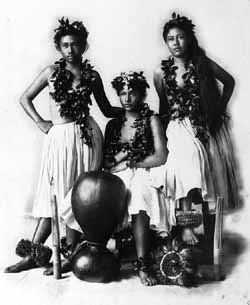
Hawaiian kings encouraged the revival of the hula despite missionary objections. King Kamehameha III attempted to revive hula about 1840, recognizing, along with other successive kings, that the extinction of the hula would mean the end of an important cultural aspect of the severely battered Hawaiian civilization. Hawaiians were already demoralized by the devastation that Western culture had wreaked on their way of life. However, it was not until the reign of King David Kalakaua ( “The Merry Monarch,” 1874 to 1891) that hula was effectively revived as an art. During his reign, professional hula troupes became popular again, entertaining people at luaus, public occasions and the theater.
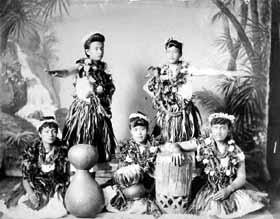
The modern instruments are old forms: the drum; split bamboo sticks; gourd rattles with feather ornaments; castanet pebbles and hardwood sticks. Beside the solemn sacred hula, there always existed a more “profane” form, to entertain and gladden the hearts of both the ali’i (royal) class and the common people. Most of today’s dances are descended from this popular type of hula.
Both men and women performed the sacred hula in ancient times, though seldom at the same time. The men’s hulas were vigorous and forceful while those of the women were more sensual and esthetic. Drawings made by the early explorers show hula dancers as energetic and manly exponents of the dance. The sacred hulas were delicate, artistic and subtle forms of dance, mastered only after long years of apprenticeship under a master teacher. Today, a rare few masters of this ancient art form carry on the tradition.
For a time, the lovely hulas of Hawai’i were in danger of disappearing forever. Thanks to the foresight and wisdom of Hawai’i’s kings, Hawai’i’s unique and graceful national dances are today more popular than ever. The revival of hula is an integral part of the Hawaiian cultural renaissance that has occurred over the last 30 years. Recently, halaus, or hula schools, have been springing up throughout the Mainland and in several countries.
Auntie Winona Beamer, Hawaiian hula master and mother of famed slack key musician, Keola Beamer described hula in Voices of Wisdom: Hawaiian Elders Speak:
In hula, the dancers become one with everything in nature. They bent, swayed and gestured, moving in countless ways to tell countless stories, most of which had deep meanings. Behind these graceful, expressive, sometimes dignified and sometimes earthy dances, lay years of study, meditation and prayer. Its your spirit, its your soul. Its unlike anybody else. This bubbling up in your heart is your personal expression, your original way of saying things. It comes from a place of love and kindness… They’ll be no obstacle if you keep your love. That’s the answer.

